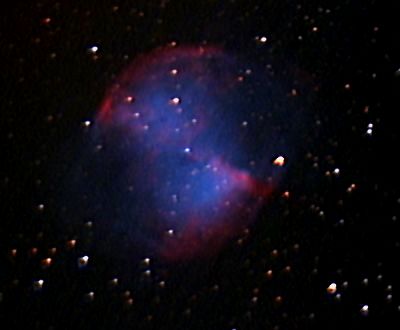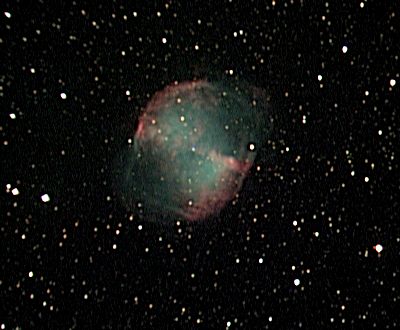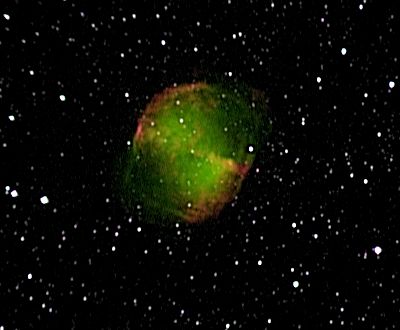

 |
M27, the Dumbbell nebula, is a planetary nebula seen almost edge on. (For a face-on example, see my picture of M57.) As DSOs go this one is comparatively close at only 1,250 light years and was formed when a star near the end of its life shed a large proportion of its atmosphere. In this case maybe only about 3 to 4 thousand years ago. The nebula has been expanding ever since. It is one of the brighter nebulae, making it a comparatively easy object. Nevertheless this picture required 60-second exposures with my unguided 10-inch LX200 fitted with a 0.33 focal reducer. Date and Time: 15th July 2006 23:41 UT Camera: Modified Toucam 840K with cooling Telescope: LX200 with 0.33 focal reducer, IR-block and Nd filters Capture: K3CCDTools. 35 frames, high gamma, 60", 43% gain Processing: K3CCDTools. 35 frames stacked, histogram 16-135, unsharp mask 3,0,100 PhotoImpact. Gamma 0.8, brightness -10, despeckled, background colour removed |
 |
Here are two pictures taken with my monochrome MX716 camera and assembled into colour by the LRGB technique. This first one is in natural colour using the Astronomik RGB and CLS filters. Date and Time: 15th November 2010 18:45 (L) and 19:21-19:38 (RGB) UT Camera: Starlight Xpress MX716 Telescope: ETX125 with 0.33 focal reducer, Astromomik CLS and RGB filters Capture: star_mx7. 10 frames for L and 5 each for RGB, 60 sec exposure. Processing: star_mx7, RegiStax, PhotoImpact and Photoshop. |
 |
This second one is in false colour using the Astronomik Hα, OIII, SII and CLS filters. I assigned the Hα image to the red, OIII image to the green, and SII image to the blue. I was surprised at the large output from Oxygen. I don't know if this is normal for planetary nebulae. Comparing this image with the one above, the green areas here are more blue in the natural-colour image. I do not have my camera and filters calibrated, but all these pictures were taken with the same camera and the same exposures. (Sadly I do not have a narrow-band blue filter.) So there seems to be a high output of blue light in these areas. Click on this picture to see the individual images. Date and Time: 15th November 2010 18:45 (L) and 18:54-19:19 (HOS) UT Camera: Starlight Xpress MX716 Telescope: ETX125 with 0.33 focal reducer, Astromomik CLS and narrow-band filters Capture: star_mx7. 10 frames for L and 5 each for RGB Processing: star_mx7, RegiStax, PhotoImpact and Photoshop. |
Home Back to DSOs